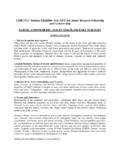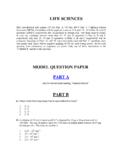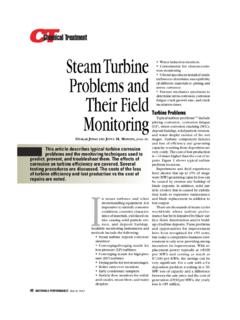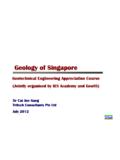Transcription of EARTH SCIENCES - Human Resource Development …
1 EARTH SCIENCES This Test Booklet will contain 150 (20 Part `A +50 Part `B+80 Part C ) Multiple Choice Questions (MCQs). Candidates are required to answer 15 in part A , 35 in Part B and 25 questions in Parts C respectively (No. of question to attempt may vary from exam to exam). In case any candidate answers more than 15, 35 and 25 questions in Parts A, B and C respectively only first 15, 35 and 25questions in Parts A, B and C respectively will be evaluated. Questions in Parts `A and B carry two marks each. In Part C each question shall be of 4 marks each. There will be negative marking @25% for each wrong answer in Part A and B , and 33% Negative marking for Part C . Below each question, four alternatives or responses are given.
2 Only one of these alternatives is the CORRECT answer to the question. MODEL QUESTION PAPER PART A May be viewed under heading General Science PART B 21. Albedo of a surface is defined by the ratio of outgoing to incoming solar radiation. Keeping this in view, which of the following surface will have the highest albedo? 1. Water 2. Sand 3. Snow 4. Forest 22. Geostrophic wind is a balance between the pressure gradient force and the Coriolis force. In non-geostrophic wind, flow will become circulatory because of 1. pressure difference term 2. momentum term 3. temperature difference term 4. shear term 23. In valley-mountain system, cold air is heavier than warm air, and thus flows down hill as a katabatic wind.
3 In the case of an anabatic wind, 1. wind rises vertically in the valley 2. wind forms updraft and downdraft motion 3. wind will flow along the slope 4. wind will have cross mountain flow 24. Cyclones or hurricanes do not develop within about 50 N and S of the equator because the 1. pressure gradient is weak 2. trade winds converge 3. ocean surface temperature is high 4. Coriolis force is very weak 25. When statically stable air flown over a hill or ridge, it is set into oscillation. These waves are known as 1. Rossby waves 2. Kelvin waves 3. gravity waves 4. mountain waves 26. A ceaseless movement of wind and ocean currents results in global circulation because of 1. unequal distribution of oceanic and continental mass 2.
4 Radiative forcing due to Sun- EARTH interaction 3. tilt of EARTH 's axis 4. revolution / rotation of EARTH 27. The organism that can take N2 directly from sea water is 1. foraminifera 2. cocolithophore 3. cyanobacteria 4. dinoflagellates 28. Which is the major limiting element in marine primary production? 1. sodium 2. nitrogen 3. carbon 4. argon 29. If the sea surface temperature is increased in Antarctic Ocean due to global warming, the dissolved oxygen in its deep water will 1. increase 2. initially increase and then decrease 3. decrease 4. not change 30. Hydrogenous sediment in the oceans is 1. derived from skeletal debris 2. precipitated by chemical or biochemical reactions 3.
5 Produced by weathering of rocks on land 4. ejected by volcanoes 31. Sea surface temperature (SST) is an important and variable parameter of oceans. In the Indian Ocean, SST variability has the largest amplitude on the timescale of 1. century 2. decadal 3. interannual 4. seasonal 32. The speed of current in the wind-driven Ekman layer 1. increases with depth 2. decreases with depth 3. remains constant 4. first decreases and then increases 33. Which one of the following is not true in case of the Arabian Sea? 1. seasonal high biological productivity 2. mid-depth oxygen minimum zone 3. net annual evaporation 4. net annual precipitation 34. Silicon limitation in the upper ocean will hamper the growth of 1.
6 Cocolithophos 2. foraminifera 3. diatam 4. corals 35. Which one of the following rock suites represents the oceanic lithosphere? 1. turbidite 2. ophiolite 3. seismite 4. granulite 36. Which one of the following is defined by shear strain? 1. change in length 2. change in angle 3. change in volume 4. change in area 37. Which one of the following is a measure of compressibility of a material? 1. elasticity (E) Young's modulus 2. rigidity (G) shear modulus 3. Poisson's ratio ( ) 4. viscosity ( ) 38. Four oxygen ions of radius rc (incompressible and touching spheres) are located at the corners of a square. What will be the radius ratio rc/ra of the cation (radius: rc) lodged at the centre of the square?
7 1. 2 2 2. 2 -1 3. ( 2 -1)/2 4. 2 +1 39. A light beam is incident on a mirror at an angle with the normal to the mirror. If the mirror is rotated in the direction of incident beam by an angle r, what will be the rotation angle of the reflected beam with respect to its previous position? 1. r 2. r + 3. r - 4. 2r 40. Coesite, a high pressure polymorph of quartz is found in rocks exposed on EARTH 's surface because, coesite 1. is stable at low temperature 2. is a high density mineral 3. is not kinetically favoured for decomposition 4. has the lowest free energy at the EARTH 's surface 41. In Al2 SiO5, the Al2O3 content (in wt %) is close to 1. 80 2. 60 3. 40 4. 20 42. In the feldspar mineral structure, chemical substitutions such as Ca2++Al3+ Na+ + Si4+ and Na+ K+ are common.
8 Amongst the feldspar group of minerals, which one should have the highest amount of Al? 1. albite 2. anorthite 3. orthoclase 4. oligoclase 43. Generation of nuclear energy requires availability of minerals containing U and Th. Which one of the following rocks is known to have high concentrations of nuclear minerals? 1. basalt 2. diorite 3. granodiorite 4. pegmatite 44. Which one of the following minerals will have no useful nutrient elements for plant life? 1. plagioclase feldspar 2. quartz 3. olivine 4. biotite 45. The atmosphere of Venus has about 97% CO2. If so, the planet should have 1. an abundance of photosynthesizing bacteria 2. an abundance of water 3. no life at all as the surface should be very hot 4.
9 An abundance of fossil fuel deposits 46. Which one of the following drainage patterns is typically associated with fold mountain belts? 1. parallel 2. rectangular 3. trellis 4. dendritic 47. If the wave front is exactly parallel to the coast, which one of the following will still occur along the coast? 1. beach drift 2. longshore drift 3. longshore current 4. wave refraction 48. A river will braid irrespective of the fact that it is gravel-bed, sand-bed or silt-bed if 1. sediment supply = sediment transport 2. sediment supply < sediment transport 3. sediment supply > sediment transport 4. sediment supply >> sediment transport 49. If gA, gB, gC and gD are the EARTH s normal gravity values at four locations A( , ), B ( , ), C ( , ) and D ( , ), then 1.
10 GA > gC ; gB = gD 2. gA < gC ; gB = gD 3. gA = gC ; gB > gD 4. gA = gC ; gB < gD 50. If R is the ratio of the EARTH s gravity field to its magnetic field at the equator, the ratio of these fields at the poles would be approximately 1. R/4 2. R/2 3. R 4. 2R 51. On the geoidal surface, the EARTH s gravity field 1. is everywhere zero 2. is a constant and is normal to the surface 3. varies along the surface, but is normal to it 4. varies in magnitude and direction along the surface 52. An isostatically compensated elevated landmass is characterized by 1. strong negative Bouguer and free-air anomalies 2. strong negative Bouguer and little or no free-air anomalies 3. strong positive Bouguer and little or no free-air anomalies 4.














